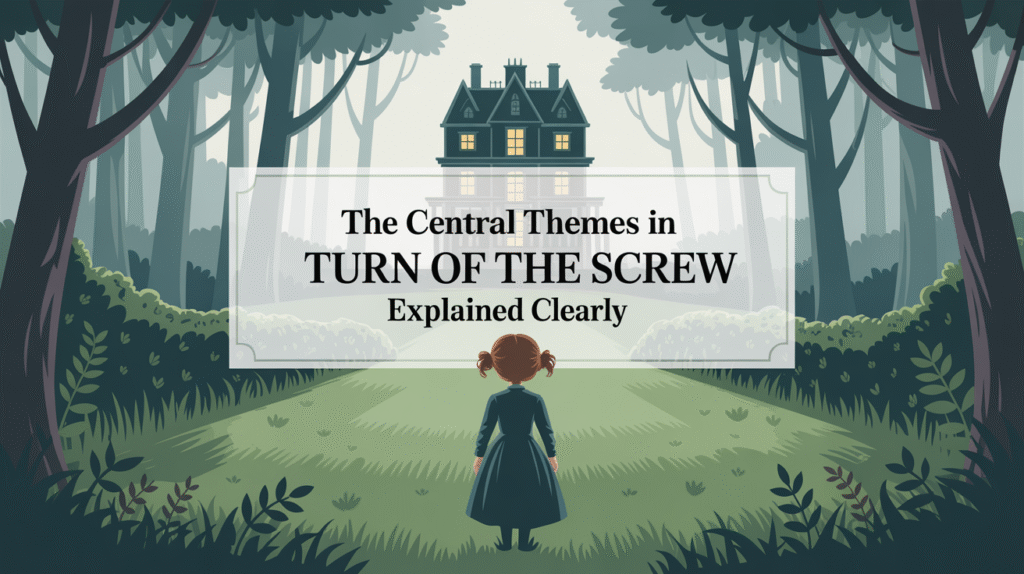The core themes of “The Turn of the Screw” revolve around ambiguity, innocence, and psychological tension, this article breaks them down for you.

Henry James’s The Turn of the Screw is more than a ghost story; it’s a masterclass in layered themes and subtle meanings. Readers have long debated what the book is really about. This article unpacks the central themes that make the novella timeless, eerie, and deeply psychological.
The Theme of Ambiguity – Ghosts or Delusion?
One of the strongest themes in the novella is ambiguity—nothing is ever fully explained, and the reader is left to decide what’s real.
The Governess’s Perception vs. Reality
The entire story is told from the governess’s point of view, raising questions about how much we can trust her.
- She describes supernatural events with great certainty, but no other character confirms them.
- Her obsession with the children’s purity blurs the line between concern and mental instability.
Supernatural vs. Psychological Horror
Is the house haunted, or is the governess mentally unraveling?
- The apparitions might be real or could be projections of a stressed, isolated mind.
- James intentionally withholds clear evidence, turning the reader into an active interpreter.
The Theme of Innocence Corrupted
Innocence and its potential corruption is a recurring theme, especially concerning the children—Miles and Flora.
The Children’s Dual Nature
The children appear angelic on the surface, but there are hints of something darker beneath.
- Miles’s expulsion from school is never fully explained.
- Flora shows odd behaviors that suggest exposure to inappropriate knowledge or influence.
The Governess’s Role
Her mission to protect the children becomes obsessive.
- Her “protection” begins to look like control.
- She might be projecting her own fears onto the children, reading malice where none exists.
Power and Authority in Isolation
The novella is set in an isolated English country house, a perfect environment for power dynamics to take hold and distort reality.
The Governess’s Authority
With no one else around to check her decisions, the governess becomes the sole arbiter of truth.
- She has total control over the children’s routines and movements.
- The lack of adult supervision from others (like the absent uncle) exacerbates the power imbalance.
Children as Pawns
The power struggle seems centered around the children, who are caught in adult conflicts they may not understand.
- Miss Jessel and Peter Quint (if real) are said to have corrupted the children.
- The governess believes saving the children requires complete emotional control over them.
The Role of Gender and Repression
Victorian society’s expectations of women and emotional restraint are subtly critiqued throughout the story.
Gendered Expectations
The governess represents the “ideal” Victorian woman—pure, moral, and submissive—but her actions reveal suppressed instincts.
- Her desire to impress the children’s uncle adds a romantic layer.
- Her breakdowns hint at the pressure of maintaining control and decorum.
Emotional Repression
The entire household operates under a veil of emotional reserve, which creates tension.
- The housekeeper, Mrs. Grose, speaks in whispers and vague terms.
- No one openly confronts what’s happening, increasing suspense.
Good vs. Evil – Or Something More Complex?
The novella plays with the theme of morality, but not in clear-cut terms.
The Ghosts as Moral Symbols
Peter Quint and Miss Jessel may symbolize corruptive forces, but they’re not fleshed out as traditional villains.
- The lack of concrete actions attributed to them adds to the confusion.
- They may be metaphorical manifestations of the governess’s inner fears.
The Children as Blank Slates
Are the children victims, or are they more knowing than they appear?
- Their reactions to the ghosts are inconsistent—sometimes terrified, other times indifferent.
- This forces the reader to constantly reevaluate their innocence.
FAQs About Central Themes in The Turn of the Screw
Here are some questions and answers about the central themes explored in The Turn of the Screw:
What is the main theme in The Turn of the Screw?
The central theme is ambiguity—readers are never sure if the supernatural elements are real or imagined.
Is the governess a reliable narrator?
Most critics agree that the governess is unreliable. Her narrative is emotionally charged, selective, and leaves out key details.
Do the children represent innocence or evil?
They represent both. James plays with the duality of childhood innocence and the possibility of early corruption, making them complex symbols.
Is The Turn of the Screw a ghost story?
Yes and no. It uses the format of a ghost story but is often interpreted as a psychological thriller focused on repression and perception.
What role does repression play in the story?
Repression—emotional, sexual, and societal—is key. The governess’s restrained behavior and hidden desires color the way she interprets events.
